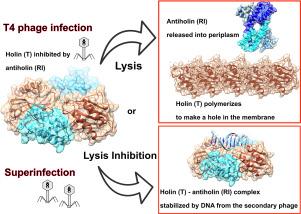Journal of Molecular Biology ( IF 4.7 ) Pub Date : 2020-06-17 , DOI: 10.1016/j.jmb.2020.06.013 Inna V Krieger 1 , Vladimir Kuznetsov 1 , Jeng-Yih Chang 2 , Junjie Zhang 2 , Samir H Moussa 2 , Ryland F Young 2 , James C Sacchettini 1

|
Optimal phage propagation depends on the regulation of the lysis of the infected host cell. In T4 phage infection, lysis occurs when the holin protein (T) forms lesions in the host membrane. However, the lethal function of T can be blocked by an antiholin (RI) during lysis inhibition (LIN). LIN sets if the infected cell undergoes superinfection, then the lysis is delayed until host/phage ratio becomes more favorable for the release of progeny. It has been thought that a signal derived from the superinfection is required to activate RI. Here we report structures that suggest a radically different model in which RI binds to T irrespective of superinfection, causing it to accumulate in a membrane as heterotetrameric 2RI–2T complex. Moreover, we show the complex binds non-specifically to DNA, suggesting that the gDNA from the superinfecting phage serves as the LIN signal and that stabilization of the complex by DNA binding is what defines LIN. Finally, we show that soluble domain of free RI crystallizes in a domain-swapped homotetramer, which likely works as a sink for RI molecules released from the RI–T complex to ensure efficient lysis. These results constitute the first structural basis and a new model not only for the historic LIN phenomenon but also for the temporal regulation of phage lysis in general.
中文翻译:

T4噬菌体裂解控制的结构基础:DNA作为抑制裂解的信号。
最佳噬菌体繁殖取决于被感染宿主细胞裂解的调控。在T4噬菌体感染中,当holin蛋白(T)在宿主膜中形成损伤时,就会发生裂解。然而,在裂解抑制(LIN)期间,T的致死功能可以被抗蛋白(RI)阻断。LIN设定感染的细胞是否会发生过度感染,然后裂解被延迟,直到宿主/噬菌体比例变得更有利于后代的释放。已经考虑到需要来自超级感染的信号来激活RI。在这里,我们报告的结构暗示了一种根本不同的模型,其中RI与T结合,而与超级感染无关,导致它以异四聚体2RI–2T复合物的形式积聚在膜中。此外,我们显示了复合物非特异性地与DNA结合,提示来自超级感染噬菌体的gDNA充当LIN信号,而通过DNA结合稳定复合物就是LIN的定义。最后,我们显示了游离RI的可溶性结构域在结构域交换的同四聚体中结晶,这很可能充当RI–T复合物释放的RI分子的沉陷,以确保有效裂解。这些结果不仅为历史性的LIN现象而且为一般的噬菌体裂解的时间调控提供了第一个结构基础和新的模型。











































 京公网安备 11010802027423号
京公网安备 11010802027423号